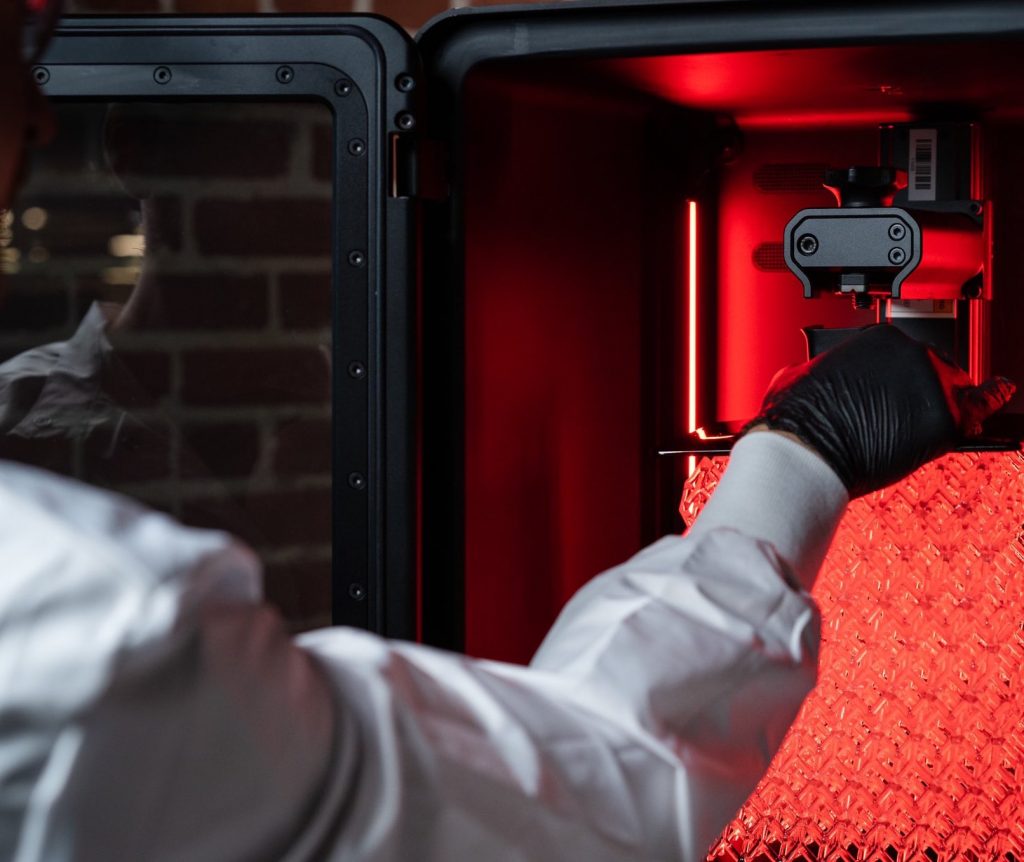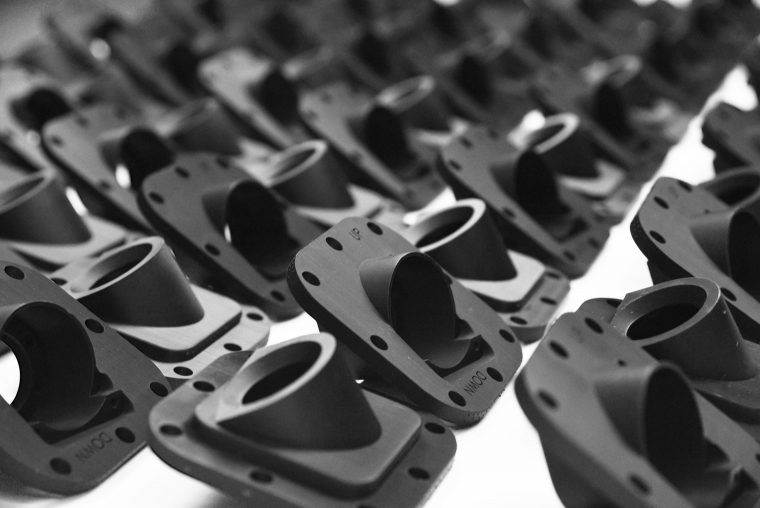Our deep dive into the State of Resin 3D Printing continues with this perspective from Fin Watterson, Director of Product Marketing, Production Photopolymers (P3), Stratasys.
Watterson joined Stratasys when Origin was acquired and here gives us his perspective on the development of the photopolymer market and value of working with the material companies who are now supplying resin for 3D printing.
We need your insights. How do you see the resin 3D printing market and where can improvements be made? Take the Spotlight on Resin 3D Printing survey now.

3DPI: How have you seen resin-based 3D printing develop in recent years?
Fin Watterson: There’s been robust and steady growth in the resin market, with most analysts predicting this trajectory to continue upwards for years to come. With this, many new material-focused companies, from startups to the largest chemical companies in the world, have been entering the photopolymer space in just the last couple of years. Some are entering from initially being involved in the industry from filaments or powders, like BASF. Others like Henkel come to the industry with a pure focus on photopolymers while material startups are formulating materials with specific value props, like Mechnano and their ESD resin.
These materials have helped fuel the industry’s growth and applications for the technology. Photopolymers are now considered and adopted for end-use parts from functional prototypes to pre-production runs and even final production parts.
Before, they did not meet the mechanical or long-term durability requirements, but that is no longer an issue.
3DPI: What do you consider the next technology hurdles for photopolymer-based 3D printing to overcome?
Fin Watterson: Photopolymer 3D printing is the oldest form of 3D printing. We’ve seen incremental improvements in part quality, build envelope size, material properties, and throughput in the last couple of decades. We will continue to see these things get even better, but right now, the technology is at the point where it’s acceptable for many production or end-use applications. The most significant hurdles are reliably scaling up production, which means robust process control, print-workflow optimization, and certifications for regulated industries.
3DPI: What applications of vat photopolymerization do you see as under-developed by the market, and why?
Fin Watterson: Thermoset photopolymers can exhibit excellent biocompatibility, heat resistance, chemical capabilities, and dielectric properties. We’ve only begun to scratch the surface of applications that require some of these qualities and would benefit from being 3D printed. Medical instruments that need biocompatibility, toughness, pleasing aesthetics, and the ability to withstand multiple sterilization cycles are good candidates for vat photopolymerization and something other 3D printing technologies are not suitable for. Printed molds are not new, but their use is limited due to printability, low-temperature materials, throughput, and surface quality. However, with the advent of high-heat materials and capable printers like the Origin One, companies like ECCO shoes have produced parts on printed molds comparable to aluminum molds, which can withstand 1000’s of shots.

3DPI: Where are opportunities for materials development in regards to vat photopolymerization technology?
Fin Watterson: The majority of commercially available today have been formulated for many applications and industries. As large OEMs adopt these materials and volumes increase, we will see more demand from customers for material properties customized for their applications. This adoption will lead to more materials being formulated and tailored for single applications. We already see this in the dental industries where materials are named after the application developed and optimized for, for example, a soft splint or gingiva mask.
3DPI: What LOCTITE resins are validated on your printing platforms?
Fin Watterson: We currently offer 9 LOCTITE resins in multiple colors for Origin One. They include best-in-class, high-impact, high-heat, medical and general-purpose materials. Customers can access even more LOCTITE and other brands’ materials through our Open Material License (OML), enabling manufacturers to develop and produce parts with unvalidated resins.
3DPI: What applications are end-users leveraging using LOCTITE 3D resins on your platform?
Fin Watterson: The applications are broad and growing almost every day. Ranging from FST (flame, smoke, and toxicity) rated electrical connectors that TE connectivity is producing at scale, or printed footwear molds that ECCO Shoes is printing in multiple countries on Origin Ones, and to medical devices such as bioreactor adapters that production service bureau InterPro is making for their medical client, Distek. These three customer application examples are produced with different LOCTITE resins on Origin One 3D printers. Other less exciting but significant examples include low-mid volume sub machinery components like clips, housings, gaskets, and holders, which otherwise would be CNC machined or produced from injection molds.
3DPI: Can you explain the value that LOCTITE 3D resins bring to your platform? How does this complement your existing/ proprietary material portfolio?
Fin Watterson: All the materials available for the Origin One are from 3rd party material developers, including Loctite, Forward AM BASF, Covestro, and Keystone. LOCTITE resins make up a significant portion of our high-performance, industrial category materials, including our highest impact strength and heat resistant materials in our portfolio. These thermoset resins have mechanical properties and UV stability comparable to commodity injection molded materials. Customers who select Origin One for end-use part production need to produce parts that can replace the traditionally manufactured part, which these high-performance materials enable. Hence, it brings tremendous value to our platform.
3DPI: Have you worked with LOCTITE to develop customized materials? If so, can you describe the collaboration process?
Fin Watterson: Our collaboration with LOCTITE and the company they acquired in 2019, Molekule, runs long and deep. From testing and providing feedback on new versions of their materials to enabling innovative materials to be printed through printer heating and control, we have a strong feedback loop that allows the groundbreaking materials we see today and will have in the future. We’ve also facilitated custom materials for our customers, for example, ECCO Shoes. The global footwear manufacturer came to Origin looking for a solution to produce large midsole molds that could withstand 1000’s of shots to replace traditionally machined aluminum molds. They tested various validated materials but needed some property customization to meet their specific application. With LOCTITE and ECCO, we developed two entirely new materials to meet their needs and adopted them into their new product development workflow.
3DPI: What LOCTITE resins have seen the most interest/use on your platforms? Any insight into why this might be?
Fin Watterson: It’s always exciting to see large aerospace OEMs get excited by parts produced on Origin One and LOCTITE 3955. 3955 is the only FST UL94 V-0, DLP resin available on the market. We’ve seen a lot in 3955 used alongside ULTEM 9085, unlocking applications that require smaller features than can be produced on FDM machines. Another material that we co-developed with LOCTITE that has seen significant interest since its launch last year is Dura-56. This general-purpose material has excellent mechanical properties and surface finish but is also low-cost and enables a cost per part that makes serial production of many applications more feasible than before.
3DPI: How do you anticipate your printer platforms that leverage Loctite resins will grow in 2022?
Fin Watterson: We will see an explosion in new applications this year. Before this year, end-use applications were from a few companies that saw the potential of 3D printing for production. This year we will see much higher adoption across different industries as companies who have been using 3D printing for prototyping primarily reevaluate the technology.
For LOCTITE, we will likely see fewer new resins but a better understanding of how the existing materials perform in different environments, different workflows, and how they can be optimized to suit specific applications.
Take the Spotlight on Resin 3D Printing survey now.
Make sure you don’t miss the results. Sign up for our free newsletter for the latest news in additive manufacturing. You can also stay connected by following us on Twitter and liking us on Facebook.
Looking for a career in additive manufacturing? Visit 3D Printing Jobs for a selection of roles in the industry. Subscribe to our YouTube channel for the latest 3D printing video shorts, reviews, and webinar replays.
Featured image shows the Stratasys Origin One 3D printer. Photo via Stratasys.



